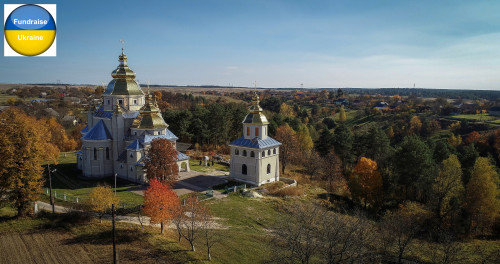
Vorobliachyn. Church of the Transfiguration of the Lord
The remains of an ancient defensive city from the period of the old Rus were discovered by archaeologists at the Zamchisko tract in Vorobliachyun. The village itself was first mentioned in 1409 in historical records. In later period, Vorobliachyn had an ancient wooden church from the XVIII century, which was transferred to a scansen in Kiev in 1980.
In the modern times, the village has a stone Church of the Transfiguration of the Lord, built in 1922 as part of the larger project by the famous Lviv architect Alexander Lushpynsky, and is a perfect example of his relentless search for the national identity and style in architecture, much like other national styles that arose in Europe at that time. The style of Lushpynsky buildings is often characterized as "Hutsul secession". The peculiarity of the style lies in elements of the traditional folk architecture, which connects it to the Ukrainian modern style of the Upper Dnipro area.
Вороблячин. Церква Преображення Господнього
У давньоруський період тут існувало оборонне місто, залишки якого відкрили археологи на вороблячинському урочищі «Замчисько». Вперше про село згадується в 1409 році. Давня дерев’яна церква існувала у селі з XVIII ст. У 1980 році її перенесли до сканзена в Києві.
У сучасній панорамі села відзначається мурована церква Преображення Господнього, збудована в 1922 році за проєктом відомого львівського архітектора Олександра Лушпинського, яка є прикладом його невпинних пошуків національного стилю в архітектурі, на зразок інших національних стилів, що виникали в тогочасній Європі. Стиль будівель Лушпинського часто характеризують як «Гуцульську сецесію». Його особливість – використання традицій народної архітектури, що зближує його з українським модерном Наддніпрянщини.
Shipping is extra.
Local pickup is available in the Toronto, Ontario area.
Taken 2019
Photo Printed on Canvas,
DJI Phantom 4 Pro
Fundraise Ukraine is backed by the Mentor Family Network Organization (MFNO). A federally registered charitable organization (732632203 RR0001)) whose team is dedicated to providing aid and assistance and settlement services for refugees and those seeking asylum in Canada.
info@fundraiseukraine.ca
info@mfno.org.